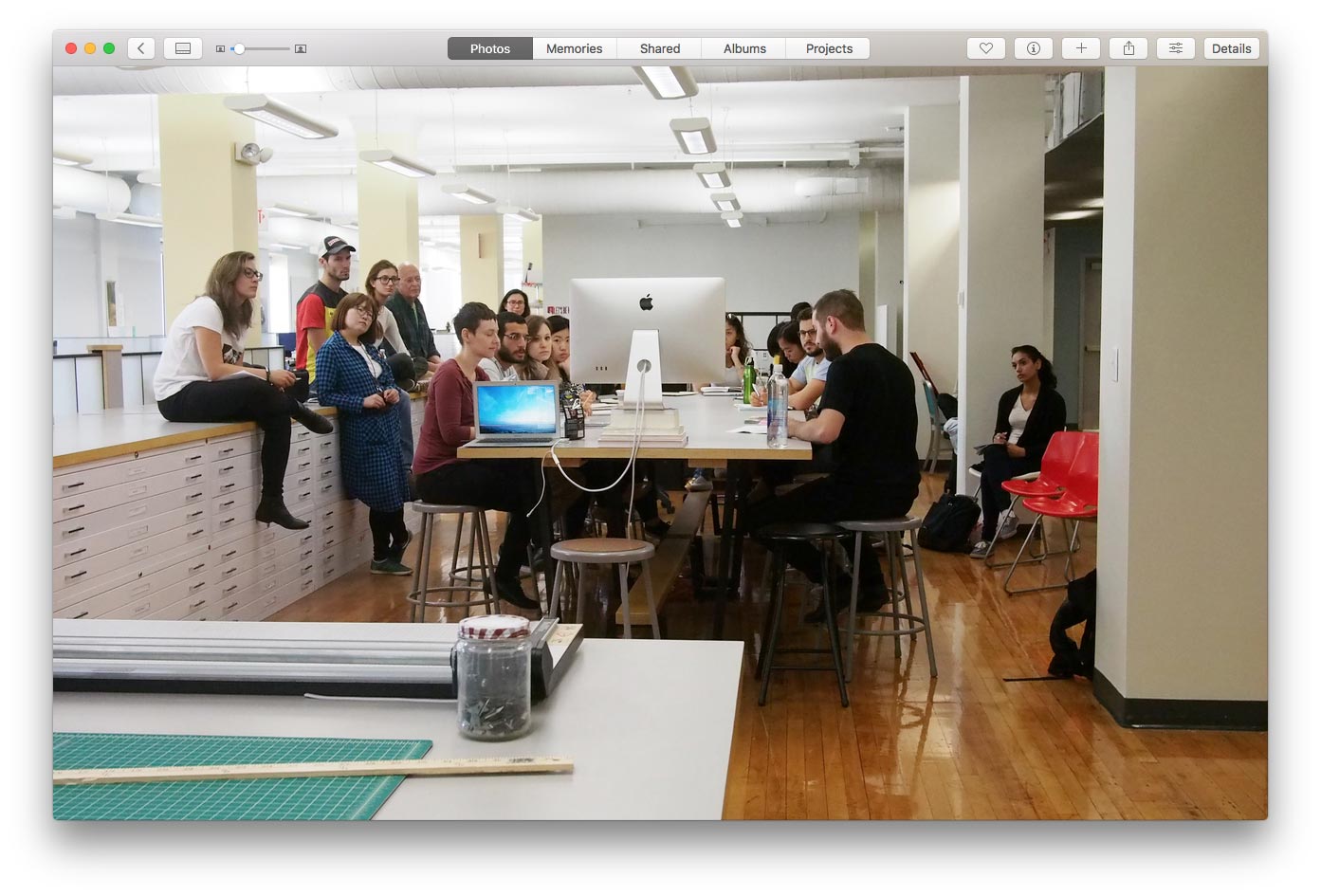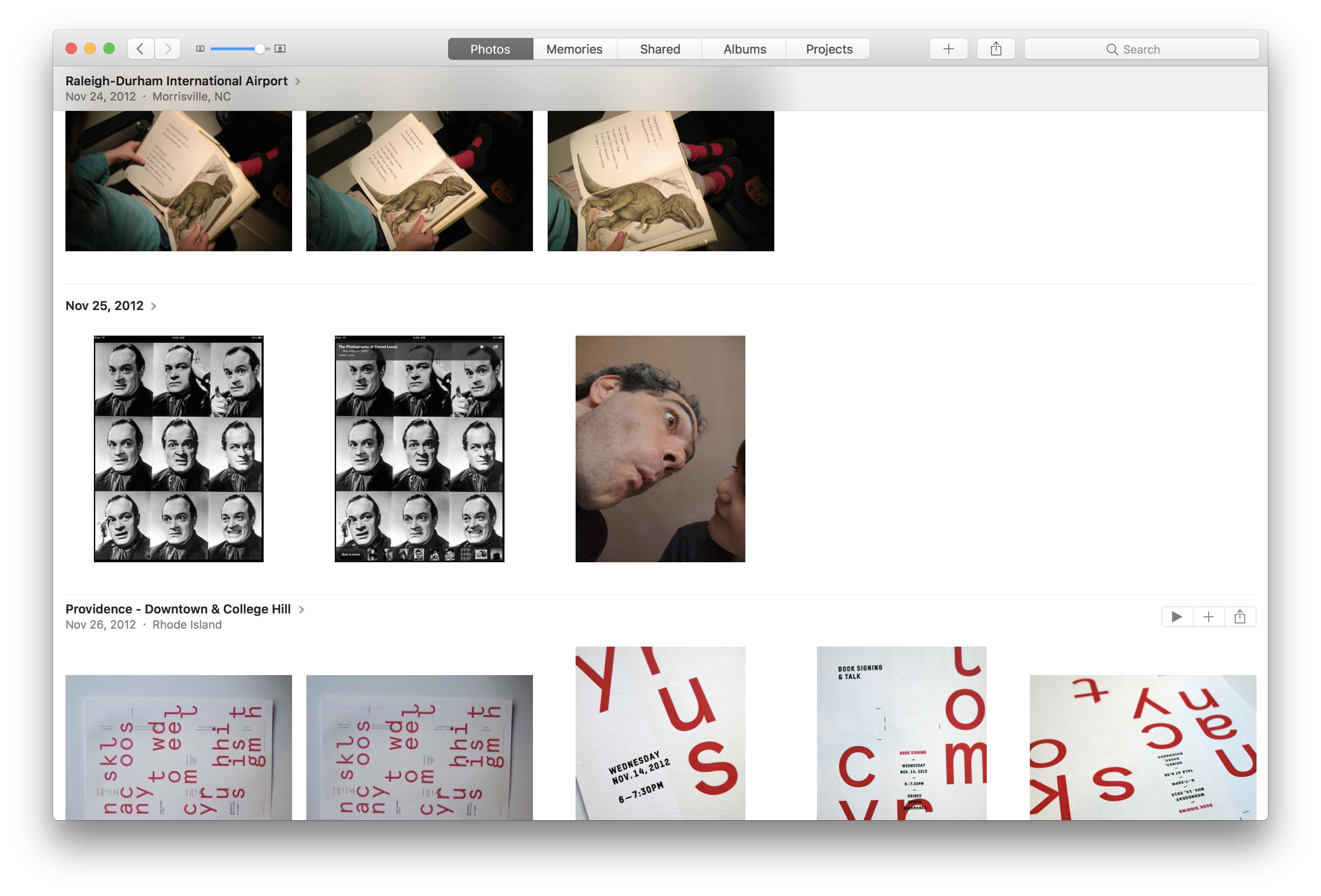Collecting work for this book has taken me back through a decade of documentation. The most informative tool in this process has been my iPhone photo archive, totaling 45,212 images and spanning ten years. The pictures show the bulk of my RISD career (which started in wintersession 2006), the birth of both of my children (2009 and 2014), the entirety of my married life (2007), and the entirety of The Design Office (2007) — my professional footprint. Life and work have had no boundaries — in iPhoto but also in real life, myLife. Observational snapshots are interspersed with pictures from the classroom. Food collides with politics. Consumption and production are at times indistinguishable.
The stream of disparate images is a metaphor of faculty life itself. I place fewer and fewer hard divisions between classroom teaching and professional practice, between Department and College, between analog and digital, between self and the collective, between past and present. The Design Office, a workspace for designers that I founded ten years ago this month, surfaces regularly in this mix. It is where I generated software tools to aid the classroom, came up with course ideas, and tested many of the organizational and collaborative methods that I put into play at RISD as Head of the Graphic Design Department. The Office has hosted events and workshops that have mixed students, alumni, professionals, and local designers.

Two projects, Web to Print and HTML Patterns, are ongoing lines of inquiry that exemplify how my work weaves in and out of academic and professional spaces. Web to Print began at The Design Office in 2013, was worked into a commission for a RISD Museum exhibition that summer, led to a spring 2014 RISD course titled HTML Output, was published later that year as a widely distributed print-on-demand book, evolved into robust open-source software (which outputs this website to a book) and has inspired a course using these principles at CCA in San Francisco. Experiments lead to courses that lead to projects that lead to lectures that lead to published artifacts that lead to alumni who create more courses, and so on.
HTML Patterns began in the classroom in 2012. As a recently hired Assistant Professor, I was looking for a way to teach design students HTML and CSS. I settled on drawing as the way to do it. Coding patterns was also part of my spring 2014 HTML Output course. I invited RISD Textiles Professor Brooks Hagan to the class so we could discuss systems of patterning with the Jacquard Loom. This conversation continued into a wintersession course he was teaching with Joy Ko. The patterns were included in a RISD exhibition and symposium on tools. Brooks commissioned a new pattern from me for his Weft, now available online.

These projects are indicative of how I like to operate. Research interests lead to speculative/initial forms that I then bring into the academic environment to pursue. This involves students, faculty, and fosters critical development. Collaborators join in as the projects instantiate themselves. The work develops locally, and in the College, but it impacts the GD profession at large. As evidenced in my curriculum vitae, the web to print work has been presented at conferences, is cited by others and has been distributed by Printed Matter, William Stout Books and European retailers. I was asked by the peer-reviewed journal Design & Culture to submit an article about this method of research. It was published in January of 2017 with the title “Question the Classroom.”

I was Department Head in Graphic Design at RISD for three calendar years starting in January of 2014. In this period, I conceived and led three major initiatives: a collaborative rescripting of the undergraduate curriculum, a redesign of spaces to promote community (graduate studio, Type Shop, Department Commons/Admin Offices, faculty hub, student co-working), and finally, the hiring and welcoming of three new faculty.
The changes were precipitated in large part to encourage human connection, sharing and experimentation — starting from the stellar reputation that my colleagues had built. Our curriculum redesign was less about new content and more about new systems. The new core studio course requires a weekly pre-class meeting by the five instructors. The teachers discuss content details and pedagogy, sharing strategies for critique, assignment mechanics and more. This has had many benefits. We benefit from our colleagues’ advice and editing because they will need to help their students. And we are much more agile in the types of faculty who can teach and how we welcome them to our culture. And the core curriculum itself is based upon faculty research ideas offered as discrete units of study.


I am institutionally minded. In a highly disciplinary College this isn’t always easy. But I believe that open and visible processes are necessary before action is taken — and action is an important part of the creative process. When I was appointed Department Head, I looked at the budget and saw unspent money allocated to remove a wall on the 5th floor of the Mason Building, where the Graphic Design and Textiles graduate programs were located. This wall closed off the Graphic Design Graduate studio and classroom from the elevator area and the bathrooms. Flat file cabinets and other storage was in the hall. The Textiles Graduate studio also shared that floor, but was behind their own door. There was a couch near the elevator, and the students shared the bathrooms. It was clear that there was more to this project than simply taking a wall down. There were security issues, shared space with Textiles, noise issues and the unknown layout of the studio once the wall were to be demolished — assuming that the whole wall would come down. In short, I had to back up and figure out what was needed, and if it made sense to do it at all.
I had an initial round of one-on-one conversations with the Head of Textiles (Brooks Hagan), the Dean of Fine Arts (Anais Missakian, who used to be the Head of Textiles), Nancy Skolos (former GD Dept. Head and Dean), GD GPD Bethany Johns and a team from facilities. I was able to build up a list of concerns, desires, and a general consensus to pursue more information. I then asked Interior Architecture Professor Peter Yeadon to join the team as a paid consultant to create a schematic design for the new space. Involving faculty on a design project itself was unusual, oddly, and took some convincing. Peter taught upstairs, worked in a co-working space in Brooklyn and is a faculty member who respects the learning environment. He was an objective, but knowledgeable, guide to understand how space could be reconfigured to benefit everyone.

Peter’s work went through a few revisions. All the while Brooks was involved, able to show the work to all involved via 3D models. Peter’s designs generated excitement and something concrete to discuss. We ended up opening up the space and creating communal work and production tables for Graphic Design. We also moved the GD students to a pre-pay printing system (students pay a fee at the beginning of the semester) to encourage collaborative work. A proper production space was made to encourage physical making. The pin-up walls were freed up, no desks were lost and Textiles installed a proper sink closer to their space. Removing a wall created more conversation and more collisions — which isn’t always friction free. But without shared things, there is little interaction. The space is light years better for Graphic Design, but is also better for Textiles. Progress for some should be progress for all.
As Department Head, I worked closely with all areas of the College: Admissions, Media, the Registrar, Facilities, Careers, Global, other academic departments and more. I also served on the Brown-RISD Dual Degree Committee, a search committee for the Registrar and a search committee for Design Director of RISD Media. This past June, I travelled to Japan with Gwen Farrelly to meet with the faculty and students at Tama Art University.

I have shown that I work well with others in the College to solve problems with everyone’s interest in mind. Former RISD Industrial Design Head Soojung Ham and I organized faculty trades to offer courses to each other’s Departments. Liliane Wong and I co-sponsored a course on exhibit design with one of our adjuncts. I worked with other heads and Academic Policies to set up 1-credit workshops. RISD Printmaking Head Henry Ferreira and I worked through logistics around sharing 48 Waterman. The studio went from a Graphic Design-only shop to a shared studio managed by Graphic Design. These discussions involved our faculty, technicians, the Registrar, Continuing Education and the deans. This was done to the disappointment of some of the GD faculty, but with great benefit to the rest of the RISD community.

My interest in the commons, the public and sharing more generally has grown since being Department Head at RISD and running The Design Office for ten years. I have become more active politically. My assignments now often include civic components. For example, the sophomores are designing four flags to be sited on the Providence River. My juniors are making sense of Federal Government labor research. The same group is animating poems to be sited inside of city busses. My current elective The Web & Democracy aims to use the web to manifest the ideals of the democracy amidst the onslaught of privatization. Can we correct the wrongs that have gotten us here? Taking my attention away from the private sector and into the public has created new avenues for my teaching and practice. This past summer I designed the campaign materials for Nirva LaFortune’s City Council campaign. Images of her campaign materials mix with early summer purple flowers. Work within the College bleeds to the outside, then back again. Nirva and Councilwoman Meghan Kallman will visit the Web & Democracy class this semester.

My journey through iPhoto led to many surprises, but maybe none more touching (professionally) than seeing a group portrait I took on the last day of class in my first semester on the full-time faculty. It is a testament not only to the power of photography, but to the intensity of classroom teaching. We spend more time with students than with anyone else at the College. The importance of this is not lost on me the more that I do it. I value my relationships with students and over the last ten years have seen students become peers. I have written an updated teaching philosophy that describes how I approach the classroom specifically.
The blurring of personal, academic and professional is what has made my work at RISD and life in Providence so productive and fulfilling. I am fortunate to have had this little camera in my pocket for these last ten years to document the journey. It has been useful for me in collecting materials for this book, but I also hope the work itself makes an impact.



